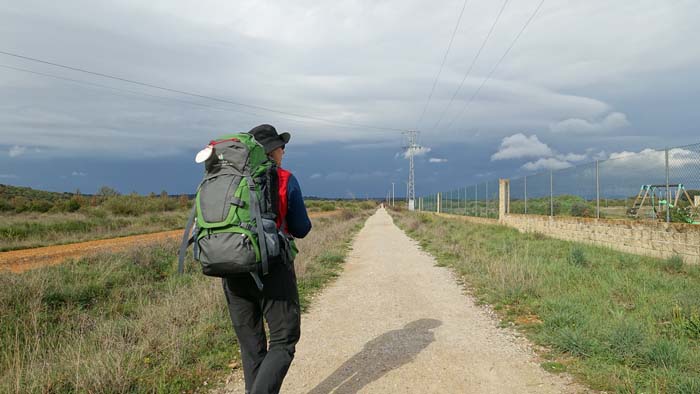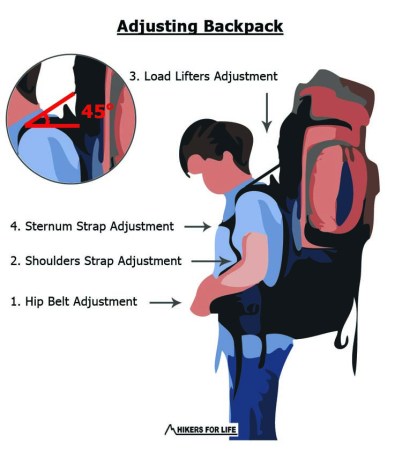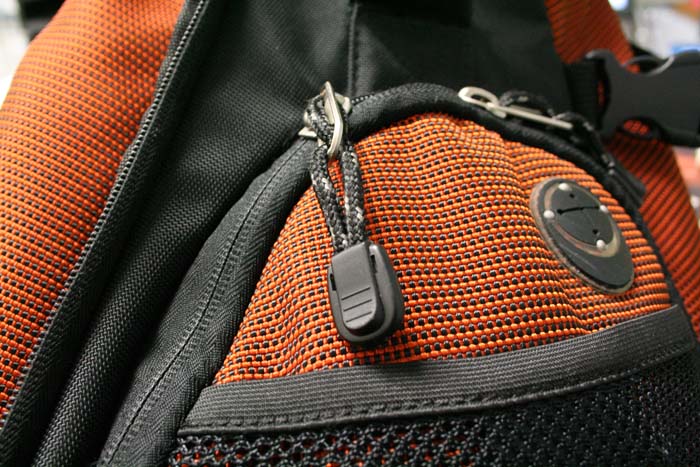This is Part 2 of a 3-part series about hiking backpacks.
Part 1 was about the features of modern backpacks.

a fitting backpacks looks nicer when you carry it
Fitting
Large backpacks come in various sizes. If you are buying a new backpack, purchase one which is fitting to your body. First, know your torso length by measuring along your spine from the base of your neck to the top of your hips.
In general,
< 15 inches - Extra Small
16-17 inches – Small
18-19 inches – Medium
> 20 inches – Large
Sizes do vary between manufacturers. If you know your torso length, check with the backpack manufacturer to know which size fits you best. Some manufacturers have height adjustable backpacks which allow you to adjust the backpacks to your torso length.
Adjustments
After choosing the backpack size which is suitable for you, do these adjustments for a further fit.

adjusting your backpack
Step 1. Hip belt adjustment
Wear the backpack so the hip belt is centred over your hipbone and resting around your hips. Fasten the hip belt and tighten it. You should feel most of the backpack’s load are now resting on your hips than on the shoulders.
Step 2. Shoulders Strap Adjustment
Pull the shoulder straps adjustment down to tighten them. The backpack load should be leaning forward resting against your back.
Step 3. Load Lifters Adjustment
The load lifters are the adjustment straps just above your shoulders. Their purpose is to lift the backpack’s shoulder strap off the top of the shoulders. Hence, the shoulder strap will only in contact with the front of your shoulder and chest area. The general rule of thumb is to have the load lifters coming down at a 45-degree angle. However, you may find that the load lifters works for you at a different angle. Find the adjustment you feel most comfortable with. The load lifter should be kept snug but not too tight.
Step 4. Sternum Strap
The sternum strap is the one in front of your chest. Adjust the strap to a suitable height and clip it across your chest in a comfortable manner. The shoulder straps should now be pulled inwards allowing your arms to rotate freely and prevented from slipping off.
Step 5. Final Adjustment
Loosen the shoulders strap just a little to have the majority of the weight transferred back to carrying by the hips.

quality matters
Backpack Purchase Consideration
When buying a backpack, I rank what features are the most important to me and filter down the list.
1. Budget
2. Backpack capacity & Design
3. Internal Framing (see notes)
4. Padded Shoulders Straps (see notes)
5. Padded Hip Straps (see notes)
6. Ventilation
7. Hydration Sleeve
8. Waterproofing (see notes)
Internal Framing Notes: I will prioritise this for backpacks above 30L, or the intend weight to be carried is above 10kg. Small backpacks do not need framing.
Padded Shoulder Strap Notes: As small backpacks usually lack a hip strap (see next point), the padding on the shoulder straps are even more important. Make sure they are comfortable, fitting to your body contours and are wide enough to distribute weight across them.
Padded Hip Strap Notes: Small backpacks usually do not have hip straps, and if they do, they are usually not padded. Small backpacks lack internal framing and their hip straps will not useful in transferring load. Hip straps on small backpacks are usually to prevent backpacks from sliding side to side or bouncing up and down against your back.
Waterproofing Notes: I placed waterproofing as the least important because, while hiking, the items inside my backpack will already be waterproof in individual zip lock packs anyway. Henceforth, not an important requirement. Furthermore, most water repellent coating inside the backpacks will degenerate overtimes and become less reliable in keeping your pack dry during a storm.
In part 3, we will focus on packing your hiking gear into the backpack.

